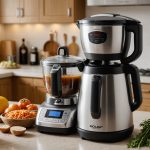Understanding Fish Scaling Tools
Choosing the right fish scaling tools is crucial for an efficient and effective fish preparation process. There are various types of fish scalers, each catering to different needs and preferences. Understanding these differences can help in selecting the best tool for the task.
Fish Scaler Types
Fish scalers come in manual, electric, and specialized forms, each offering unique benefits. Manual fish scalers are often lauded for their simplicity and control, ideal for smaller fish and lightweight tasks. Conversely, electric fish scalers offer speed and efficiency, especially valuable when working with larger quantities or larger fish types. Additionally, some scalers are designed specifically for certain species, adapting the tool’s features to the fish’s particular scale structure.
In the same genre : The Definitive Guide to Selecting a Dependable and Versatile Mandoline Slicer
Choosing Fish Scalers
When choosing a fish scaler, consider the size and species of fish you typically prepare. Manual options are a great starter choice for hobbyists, providing precise control. If time efficiency is your priority, an electric scaler might be preferable. Look for features such as ergonomic handles, durable materials, and ease of cleaning, as these significantly impact the tool’s usability and longevity.
By understanding these nuances, selecting the right fish scaler becomes a more informed process, enhancing your overall fish scaling experience.
In the same genre : Savoring Health: Crafting Irresistibly Delicious Low-Fat Slow Cooker Recipes!
Manual vs Electric Fish Scalers
Selecting between manual fish scalers and electric fish scalers requires understanding each type’s pros and cons.
Manual Fish Scalers
Manual fish scalers are favoured for their simplicity and precision. They provide excellent control, allowing users to scale smaller fish easily. Due to their straightforward design, they require minimal maintenance and can be utilised in various settings without the need for electrical power. However, they may demand more physical effort and time, particularly when handling larger batches of fish.
Electric Fish Scalers
On the other hand, electric fish scalers offer speed and efficiency, especially when dealing with larger quantities of fish. Powered by electricity, these devices can scale fish much faster than manual alternatives, making them ideal for those prioritising time. The downside is the reliance on a power source and potentially more complex maintenance procedures.
Comparative Analysis
When weighing the effectiveness of manual tools versus electric options, the choice often depends on the specific needs of the user. Manual scalers excel with precision for smaller tasks, while electric ones handle bulk scaling. Users should consider factors like fish size, quantity, and personal preference to determine which type best suits their requirements.
Top-Rated Fish Scalers Reviewed
Discovering the best fish scalers in the market can significantly enhance your fish preparation efforts. Various influential models lead the charge, offering diverse functionalities to cater to different preferences.
Among manual scalers, the [BRAND X MANUAL SCALER] emerges as a top pick noted for its simplicity and accuracy. Users praise its ergonomic design and durable build, making it excellent for those who value control and tactile feedback.
Conversely, the electric category is dominated by the [BRAND Y ELECTRIC SCALER], which stands out for its speed and efficiency in handling larger quantities of fish. Users appreciate its robust motor and ease of use, although some caution that its maintenance can be slightly more demanding.
When evaluating these top-rated fish scalers, consider features like pricing, user feedback, and the value they offer. The [BRAND X MANUAL SCALER] might be more budget-friendly, suitable for occasional use, whereas the [BRAND Y ELECTRIC SCALER] may offer more for regular, high-volume scaling tasks.
Ultimately, choosing fish scalers that align with your needs—considering the type of fish, your scaling frequency, and ease of handling—is essential for the best fish scaling experience.
Tips for Effective Fish Scaling
Creating the perfect fish dish starts with understanding the art of scaling. Using the right fish scaling tips can significantly enhance your culinary skills and ensure a smooth preparation process.
Scaling Tips and Techniques
Scaling fish efficiently involves specific steps and considerations. Always begin by choosing a suitable location or surface to prevent scales from scattering. Ensuring you have the proper fish scaling tools on hand before you start is also crucial.
- Grip and Position: Hold the fish firmly by the tail, keeping your hand away from the scaling motion to avoid injury.
- Scaling Direction: Move from tail to head in gentle strokes, employing your chosen fish scaler. This direction typically maximizes scale removal while reducing skin damage.
- Water Technique: Scaling fish under running water can help minimize the mess created by removed scales.
Mistakes to Avoid
Avoid common pitfalls like using excessive pressure, which can pierce the skin and leave bitter taste behind. Selecting the incorrect fish scaler types can also complicate the process, so understand the tool suited for the fish species you are working with. Remember, practice and patience are key to mastering the art of fish scaling, ensuring both precision and cleanliness.
Video Demonstrations and Tutorials
Watching fish scaling videos can enrich your understanding of effective scaling methods, offering a dynamic way to grasp intricate techniques. Visual aids cater to various learning styles, making the process of learning how to scale fish more accessible and engaging.
Suggested Video Resources
Engage with scaler demonstrations that walk you through the nuances of using different types of fish scaling tools. These videos are designed for both beginners and seasoned fish enthusiasts, focusing on practical steps to achieve clean and efficient scaling.
Highlighting Techniques
Tutorials showcasing how to scale fish can uncover not only basic but also advanced scaling techniques. Videos often emphasise the importance of using the appropriate tool for the fish species, highlighting consistent methods that lead to better results. This includes tips on maintaining the speed and rhythm needed for electric tools or the finesse required for manual options.
By incorporating visual elements, you gain insights into the practical application of both manual fish scalers and electric fish scalers. This enriched perspective allows you to appreciate the subtleties involved in fish preparation, providing a well-rounded understanding of the process.
Maintaining Your Fish Scalers
Preserving the efficiency and longevity of your fish scaling tools relies heavily on proper maintenance practices. A clean scaler not only guarantees optimal performance but also extends the tool’s lifespan. Here’s how to maintain your scalers effectively.
Cleaning and Care
After every use, clean your fish scalers carefully to prevent residue buildup. For manual fish scalers, rinse the tool under warm water, using a brush to remove any scales stuck between teeth. For electric options, follow the manufacturer’s cleaning instructions closely, often involving a detachable head that needs rinsing. Thorough drying is crucial to prevent rust.
Troubleshooting Common Issues
Should your scaler exhibit decreased performance, inspect it for dull edges or corrosion. Electric fish scalers may require occasional motor checks, ensuring connections are secure. If manual tools feel inefficient, evaluating the sharpness of the scaling surface can pinpoint issues.
Replacement and Upkeep
Knowing when to replace your scaler is key to maintaining efficiency. If consistent cleaning and troubleshooting fail to restore functionality, consider investing in a new tool. Regular upkeep, such as sharpening manual scaler teeth, maintains effectiveness. Embracing proper scaler maintenance enhances overall reliability in fish preparation.




